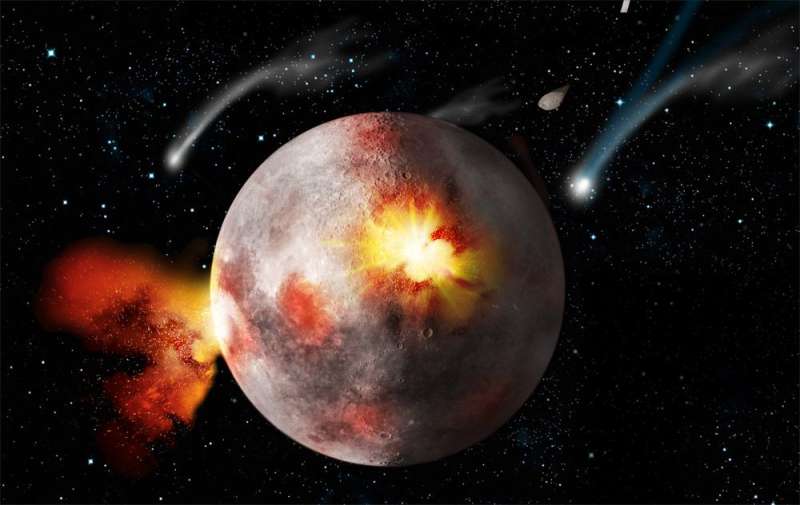October 4, 2016 report
Researchers question Apollo-era evidence for the Late Heavy Bombardment

(Phys.org)—Many scientists believe that a cataclysmic series of impact events called the Late Heavy Bombardment (LHB) occurred around 4.1 to 3.9 billion years ago, during which there was a spike in asteroids colliding with the planets of the inner solar system. Among the possible explanations for the LHB is the migration of large planets to the outer solar system, disrupting objects in the asteroid belt and the Kuiper belt and flinging them toward the inner solar system.
The Earth is constantly resurfaced by erosion and cratonic growth, and as a result, can't contribute much geologic data about the existence of the LHB. Much of the evidence is therefore derived from the moon—specifically, from Apollo-era lunar samples returned to Earth in the 1960s and 1970s. Researchers used argon dating to determine age spectra of lunar rocks found in three major lunar basins. The so-called "plateau ages" of these rocks, as determined from 40Ar/39Ar age spectra, suggest a cluster of impacts approximately 3.9 billion years ago.
But these results are controversial—Apollo lunar samples represent only about 4 percent of the lunar surface and could thus have resulted from a single impact event rather than a more widespread bombardment episode. And due to lunar magnetism and overprinting from successive impacts, all of the Apollo-era lunar samples show evidence of 40Ar/39Ar age spectrum disturbances—in other words, the apparent ages of samples could have been "reset" by later impact events.
So two researchers from the Department of Earth, Planetary and Space Sciences at the University of California, Los Angeles, recently reanalyzed the age spectra data from the Apollo samples in order to test the uniqueness of their impact histories. To do so, they used a physical model describing 40Ar* diffusive loss that accounted for age resetting of samples by subsequent impacts. The point of this reanalysis wasn't to confirm or disconfirm the existence of the Late Heavy Bombardment, but rather to determine whether 40Ar/39Ar can even act as evidence for impact spikes.
Their results, recently published in the Proceedings of the National Academy of Sciences, strongly suggest that episodic crust formation occurring more than 4 billion years ago, combined with 40Ar* loss due to a decrease in impact flux can create a bias in age compilations toward the illusion of an impact spike. "Our modeling shows that, due to the nature of declining impact rates and the early but episodic nature of crust formation on extraterrestrial bodies, apparent bombardment episodes can be a common artifact in 40Ar/39Ar plateau age histograms," the authors write.
They note that although the most widely cited evidence in favor of the LHB likely yields unreliable impact histories, their modeling does not preclude the occurrence of such events. However, determining impact histories will rely on future studies incorporating such techniques as in situ 40Ar/39Ar modeling and quantitative thermochronologic modeling. "Until such evidence is gathered," the authors write, "we conclude that a monotonic decrease in impactor flux explains all existing 40Ar/39Ar data from both lunar and meteoritic samples."
More information: Illusory Late Heavy Bombardments. PNAS (2016). DOI: 10.1073/pnas.1611535113
Abstract
The Late Heavy Bombardment (LHB), a hypothesized impact spike at ∼3.9 Ga, is one of the major scientific concepts to emerge from Apollo-era lunar exploration. A significant portion of the evidence for the existence of the LHB comes from histograms of 40Ar/39Ar "plateau" ages (i.e., regions selected on the basis of apparent isochroneity). However, due to lunar magmatism and overprinting from subsequent impact events, virtually all Apollo-era samples show evidence for 40Ar/39Ar age spectrum disturbances, leaving open the possibility that partial 40Ar* resetting could bias interpretation of bombardment histories due to plateaus yielding misleadingly young ages. We examine this possibility through a physical model of 40Ar* diffusion in Apollo samples and test the uniqueness of the impact histories obtained by inverting plateau age histograms. Our results show that plateau histograms tend to yield age peaks, even in those cases where the input impact curve did not contain such a spike, in part due to the episodic nature of lunar crust or parent body formation. Restated, monotonically declining impact histories yield apparent age peaks that could be misinterpreted as LHB-type events. We further conclude that the assignment of apparent 40Ar/39Ar plateau ages bears an undesirably high degree of subjectivity. When compounded by inappropriate interpretations of histograms constructed from plateau ages, interpretation of apparent, but illusory, impact spikes is likely.
Journal information: Proceedings of the National Academy of Sciences
© 2016 Phys.org




















